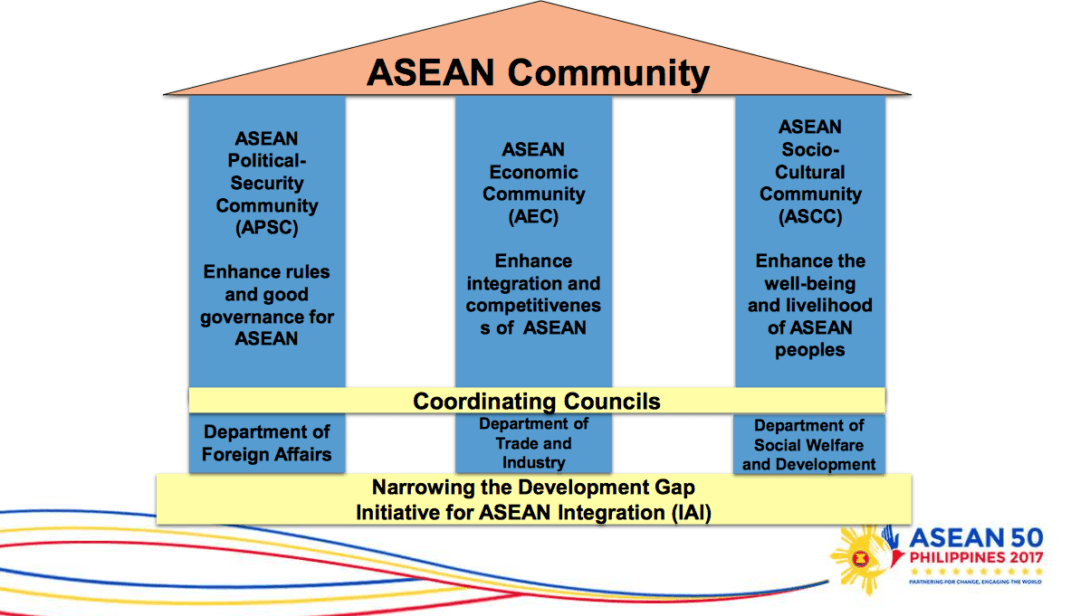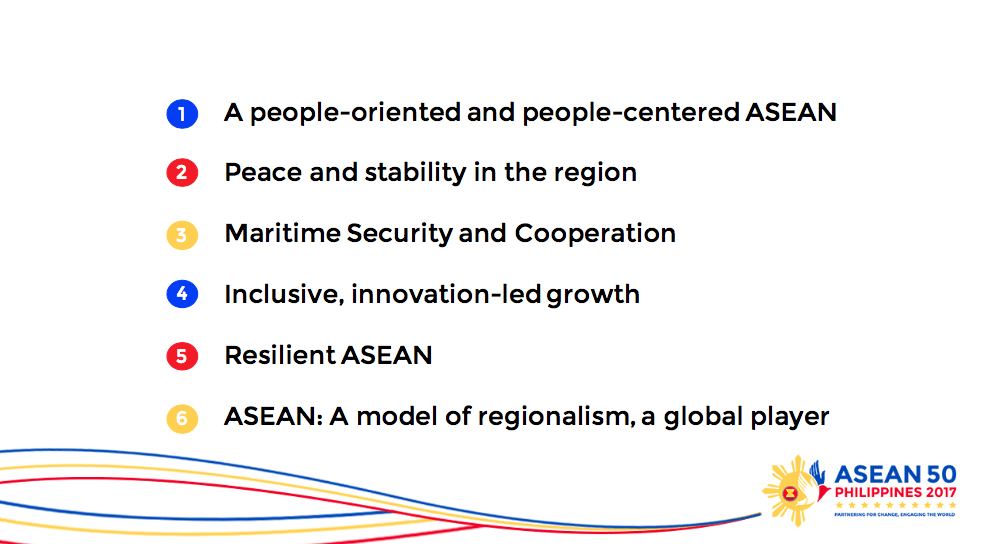When the Philippines assumed the ASEAN Chairship, the country launched the six thematic priorities for the 3 pillars of ASEAN Community under the theme, “Partnering for Change, Engaging the World”. Aside from the usual meetings, festivities were planned as the 2017 hosting coincided with ASEAN’s golden anniversary. Furthermore, information and cultural campaigns were lined up, to level up the ASEAN understanding of the general public.
To most Filipinos, knowledge of ASEAN is limited to social studies. But because of the territorial dispute at West Philippine Sea, the awareness level also increased. On the practical side, Filipinos are aware of the visa free entry to ASEAN countries and the fave tourist spots. Aside from that, nothing else ring a bell. Ooops, I stand corrected, we also remember ASEAN because of her food. For instance, when I eat Pho, Vietnam is in my mind, Tom Yum- Thailand and Hainanese chicken- Singapore.
By the way, I am writing this post because I need to lay the foundation for my upcoming other ASEAN articles. We cannot appreciate where ASEAN is heading, unless we understand what ASEAN has done so far.
ASEAN Community Backgrounder
Though ASEAN was founded in 1967, only in 1997 or after the 9 of the 10 South East Asian (SEA) countries are on board, that the ASEAN Vision 2020 was adopted. It’s the shared vision for SEA nations to be outward looking, living in peace and prosperity. Bonded in dynamic development in a community of caring societies.
At the 9th ASEAN Summit in 2003, now with all 10 member nation on-board, it was agreed to establish an ASEAN Community consistent with the 2020 Vision.
And in 2007, the regional grouping decided to fast track the establishment of the ASEAN Community: One vision, one identity and one community. The ASEAN community will be anchored on these three pillars:
ASEAN Political-Security Community (APSC)
- A rules-based, people-oriented, people-centred ASEAN in a region of peace, stability and prosperity;
- A consolidated ASEAN Community;
- A dynamic, resilient and harmonious community able to effectively respond to social and economic vulnerabilities and other non-traditional security threats;
- A Community that can respond effectively to challenges affecting ASEAN from within and beyond the region;
- A Community that steadfastly maintains ASEAN centrality in regional mechanisms;
- Strengthened ASEAN unity and cohesiveness to protect its leading and central role in dealing with matters of common concern; and
- Enhanced dialogue and cooperation with ASEAN external partners for mutual benefit and interest.
ASEAN Economic Community (AEC)
- A well integrated and connected economy within the global economic system;
- A business-friendly, trade-facilitative, market driven and predictable environment which inspires investor confidence;
- A region with a key role in global value chains and increasing participation in high value added and knowledge-based activities;
- A competitive and dynamic region that inspires innovation and where businesses of all sizes thrive, and where consumers’ rights are protected;
- A community where the benefits from economic integration are equitably shared among and within ASEAN Member States, including with micro, small and medium enterprises, youth, and women entrepreneurs; and
- A connected region where improvements in transport linkages and infrastructure help peoples and businesses move efficiently and work more productively across borders, expand market reach and strategically source goods and services.
ASEAN Social Cultural Community (ASCC)
- An inclusive Community that is people-oriented, people-centred and promotes a high quality of life and equitable access to opportunities for all, and engages relevant stakeholders in ASEAN processes;
- A sustainable Community that promotes social development and environmental protection through effective mechanisms to meet current and future needs of the peoples;
- A resilient Community with enhanced capacity to continuously respond and adapt to current challenges and emerging threats; and
- A dynamic, open, creative and adaptive Community with an ASEAN identity reflecting the region’s collective personality, norms, values and beliefs as well as aspirations as one ASEAN Community.
THEREFORE, in 2015, ASEAN “formalized” the creation of the ASEAN Community and the “declaration” of ASEAN 2025: Forging Ahead— the 10 year roadmap of the ASEAN Community.
With the Philippine hosting and Chairship of ASEAN 2017, she is bringing the regional grouping a step closer to the realization of the ASEAN Community. All activities are meant to strengthen the three pillars by focusing ASEAN 2017 energy on the six thematic priorities. What are these?
The Six Thematic Priorities of the Philippines as Chair of ASEAN 2017
Pillar 1: ASEAN Political-Security Community (APSC)
Thematic priorities:
- Peace and stability in the region
ASEAN’s commitment to uphold peaceful co- existence and regional partnership among its member states.
- Maritime security and cooperation
ASEAN’s adherence to the rule of law for the peaceful resolution of disputes and the preservation and protection of maritime resources.
- ASEAN: A model of regionalism, a global player
The ASEAN Community, led by the Philippines, aim to showcase its various capacities as a global player in the international arena.
Pillar 2: ASEAN Economic Community (AEC)
Thematic priority:
- Inclusive, innovation-led growth
As Chair, PH will facilitate discussion and provide recommendations so ASEAN can provide opportunities for business growth to improve regional capacity in responding to the demands of the global economy
Pillar 3: ASEAN Socio-Cultural Community (ASCC)
Thematic priorities:
- A people-oriented and people-centered ASEAN
The welfare of her citizens is at the center of ASEAN’s priorities. The community protects their rights and recognizes that their well-being is key to the region’s progress.
- ASEAN’s resiliency
The ASEAN Community to cultivate a sustainable region that is prepared and responsive to disasters
After reading through this post, whenever ASEAN will come to mind…
Think of your and the future’s peace and security. Member countries are collaborating to keep regional peace, and prioritize the safety for its citizen
Think that one day, ASEAN will be community of opportunities where small and medium enterprise trading services and goods will eventually have no bounderies .
And finally, think of a community wherein people’s rights and welfare is at the center of ASEAN priority
Do you think ASEAN Community’s aspirations are doable? Share your thoughts and let’s discuss.
Discover more from ASKSonnie.INFO
Subscribe to get the latest posts sent to your email.







